| Srl | Item |
| 1 |
ID:
099602
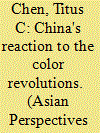

|
|
|
| 2 |
ID:
064565
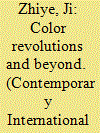

|
|
|
| 3 |
ID:
066866
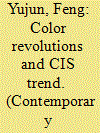

|
|
|
| 4 |
ID:
127636
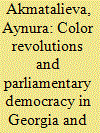

|
|
|
|
|
| Publication |
2013.
|
| Summary/Abstract |
The media of Kyrgyzstan described Georgia after the Rose Revolution of 2003 as a country that has made giant strides in economic recovery, suppressing corruption, and reform of its police and education system. The two countries increased their cooperation after the Tulip Revolution of 2010 in Kyrgyzstan; today, it has taken the form of an exchange of diplomatic and political experience and youth programs. Trade turnover between the two countries is expected to top $1.4 million.
These two Soviet successor-states, which adhere to different sociocultural and economic traditions, chose a practically identical road leading first to the presidential form of government and then to parliamentary democracies. This choice made after the color revolutions of 2003 in Georgia and 2005 and 2010 in Kyrgyzstan was suggested by the universal model of democracy that had gained popularity all over the world and was primarily a mechanism for legitimizing the power of the new people inside and outside the country. So far, parliamentary democracy in both countries has not developed enough to produce unambiguous results. It is much more important to understand how the changes were accepted and substantiated through an analysis of public discussions, discussions in the media and on the Internet, as well as in official documents, interviews, and statements by the leaders.
|
|
|
|
|
|
|
|
|
|
|
|
|
|
|
|
| 5 |
ID:
127579
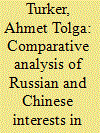

|
|
|
|
|
| Publication |
2012.
|
| Summary/Abstract |
In addition to the recent violent ethnic conflict in Kyrgyzstan, some of the other events attracting attention to politics in Central Asia are the Georgian-Russian war, the Color Revolutions, the Andijan events in Uzbekistan, the Karimov government's subsequent decision to end U.S. basing rights, Kazakhstan's economic rise, and the leadership change in Turkmenistan. At the same time, the security situation in Afghanistan and the growing insecurity about energy supplies has heightened the interest in security and economic cooperation in Central Asia. Russia and China have been reacting to these same pressures.
|
|
|
|
|
|
|
|
|
|
|
|
|
|
|
|
| 6 |
ID:
139284
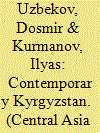

|
|
|
|
|
| Summary/Abstract |
The authors undertake the challenging task of going to the roots of the political instability that enveloped Kyrgyzstan during the period of democratic transit and discover that the bureaucratic state cannot adapt democratic values to the local conditions and, most importantly, does not want to do this. The political elite of Kyrgyzstan, which remains under the spell of Soviet political and spiritual legacy and which has been exhausted by two coups, demonstrates a very low level of cohesion and weakened political will. The authors describe the ways and means that will help the state and society remove the obstacles and remedy the shortcomings to finally acquire political stability and move forward.
|
|
|
|
|
|
|
|
|
|
|
|
|
|
|
|
| 7 |
ID:
127118
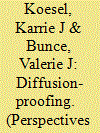

|
|
|
|
|
| Publication |
2013.
|
| Summary/Abstract |
Do authoritarian leaders take preemptive actions to deter their citizens from joining cross-national waves of popular mobilizations against authoritarian rulers? Are they more likely to engage in such behavior when these uprisings appear to be more threatening-in particular, when they take place in neighboring countries and in regimes that resemble their own? We provide answers to these questions by comparing the responses of the Russian and Chinese leadership to two such waves: the color revolutions and the Arab uprisings. We conclude that, despite differences in the ostensible threats posed by these two waves, they nonetheless prompted the leaders of both of these countries to introduce similar preemptive measures in order to "diffusion-proof" their rule from the color revolutions and the Arab upheavals. These findings have some important implications for our understanding of authoritarian politics and diffusion processes. One is to reinforce the emphasis in many recent studies on the strategic foundations of authoritarian resilience. That recognized, however, we would add that the authoritarian toolkit needs to be expanded to include policies that preempt international, as well as domestic threats. The other is to provide further confirmation, in this case derived from the behavior of authoritarian rulers, of how scholars have understood the drivers of cross-national diffusion. At the same time, however, we counsel students of diffusion to pay more attention to the role of resisters, as well as to adopters. In this sense, the geographical reach of diffusion is much broader than many analysts have recognized.
|
|
|
|
|
|
|
|
|
|
|
|
|
|
|
|
| 8 |
ID:
147776
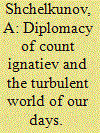

|
|
|
|
|
| Summary/Abstract |
RESTORING THE DEEDS of historical personalities on the basis of a vast body of archival materials is like rebuilding churches and monasteries ruined by alien ideas and base passions. The outlines of the impressive building that fell victim to the wickedness of those who planted base feelings and stirred up base passions in our people are gradually coming through. Blinded by false ideals people revenged their hopeless misery on architectural masterpieces built to inspire.
|
|
|
|
|
|
|
|
|
|
|
|
|
|
|
|
| 9 |
ID:
192426
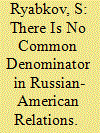

|
|
|
| 10 |
ID:
107109
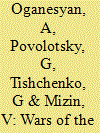

|
|
|
|
|
| Publication |
2011.
|
| Summary/Abstract |
Unfortunately, the new millennium has not brought peace to mankind. The global agenda still includes the security problem, the resolution of armed conflicts and the prevention of new wars. Realizing the importance of the subject, the International Affairs ' editorial board and the Institute of International Studies at the Moscow State Institute (University) of International Relations invited experts and analysts to discuss the military concepts that are being developed in the world today and the weapons that could be used in future armed conflicts.
|
|
|
|
|
|
|
|
|
|
|
|
|
|
|
|